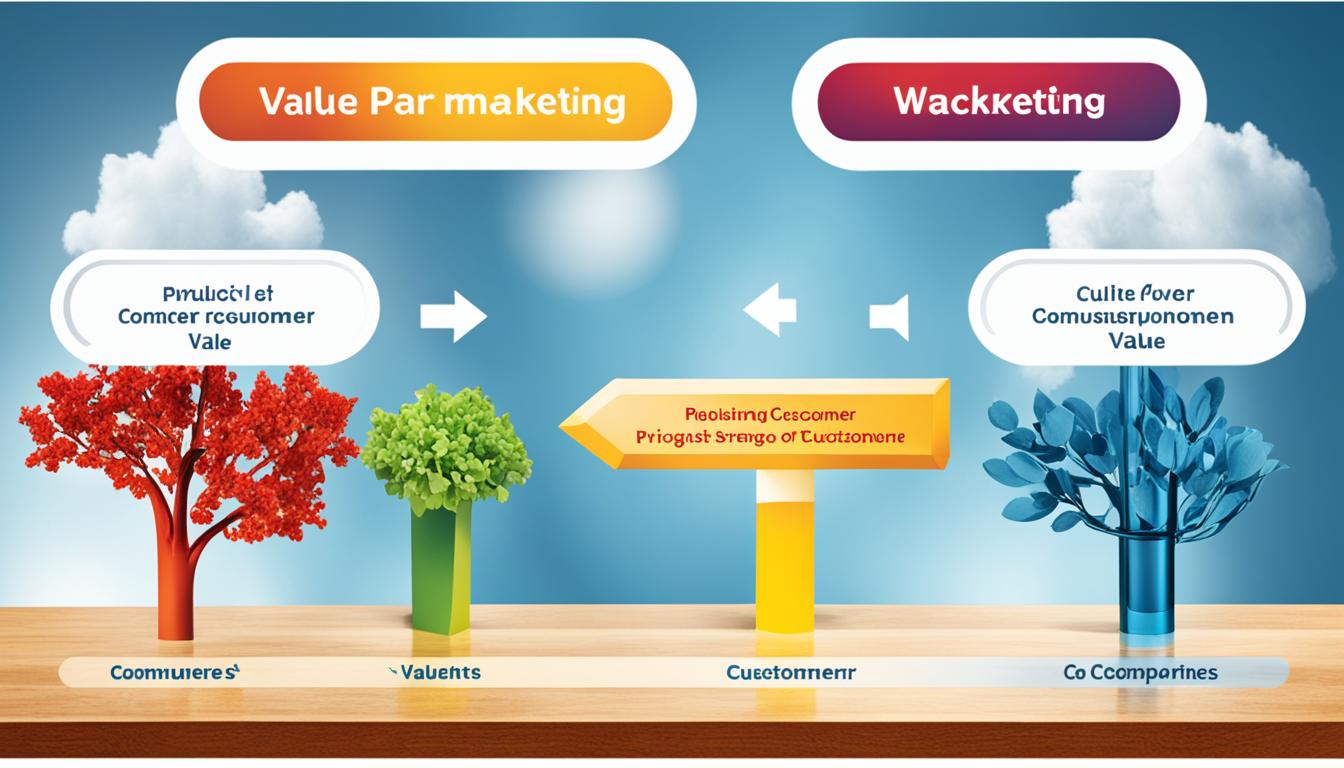Cross-channel marketing is an essential strategy in today’s consumer landscape. With customers utilizing multiple channels during their online shopping journey, businesses need to adopt a cross-channel approach to effectively reach and engage their target audience. This section explores the importance of cross-channel marketing, differentiating it from multichannel marketing, and highlighting its numerous benefits.
Unlike traditional multichannel marketing, which uses independent channels that operate in silos, cross-channel marketing takes an integrated approach. It combines various marketing channels, such as email, social media, search engines, and mobile apps, to create a unified customer experience. By providing a seamless and cohesive brand experience across all touchpoints, businesses can significantly increase engagement, enhance conversion rates, and improve the overall customer experience.
One of the key advantages of cross-channel marketing is the ability to map and understand the customer journey. By analyzing data from different channels, businesses can gain valuable insights into customer behavior, preferences, and pain points. This data-driven approach allows for more targeted and personalized marketing campaigns, resulting in higher customer satisfaction and increased brand loyalty.
Another crucial aspect of cross-channel marketing is brand consistency. Maintaining consistent messaging, tone, and branding across all channels and platforms helps establish a strong brand identity and fosters trust with customers. This consistency reinforces the overall brand experience and ensures that customers receive a cohesive message regardless of the channel they interact with.
Furthermore, cross-channel marketing allows businesses to optimize their marketing efforts. By monitoring and analyzing the performance of each channel, businesses can make data-driven decisions to allocate resources effectively and optimize campaign strategies for maximum impact. This channel optimization ensures that the right message is delivered through the most appropriate channels, increasing the effectiveness and efficiency of marketing campaigns.
Key Takeaways:
- A cross-channel marketing strategy is crucial in reaching and engaging with today’s multi-channel consumers.
- Cross-channel marketing provides a seamless and cohesive customer experience, leading to increased engagement and higher conversion rates.
- Data-driven insights from cross-channel marketing help businesses understand the customer journey and tailor marketing campaigns accordingly.
- Consistent branding across all channels fosters trust and loyalty among customers.
- Optimizing marketing efforts through channel analysis allows businesses to allocate resources effectively and improve campaign performance.
What is Cross Channel Marketing?
Cross Channel Marketing refers to the strategic use of multiple marketing channels to reach and engage with a target audience. It entails creating a seamless and cohesive experience for consumers across various social media sites and touchpoints. By leveraging diverse channels such as email, social media, websites, and mobile apps, businesses can connect with customers at different stages of their journey and deliver personalized messages and offers.
One key aspect of Cross Channel Marketing is the coordination of messages and campaigns across different platforms. To streamline this process, businesses can utilize social media management tools that enable the centralization of content creation, scheduling, and reporting. By leveraging these tools, marketers can ensure consistent messaging while efficiently managing their cross-channel marketing efforts.
The image above visually represents the concept of Cross Channel Marketing, demonstrating the interconnectedness of various marketing channels to create a comprehensive and integrated approach. It illustrates the idea of seamlessly guiding customers through their journey across multiple touchpoints to deliver a unified brand experience.
By implementing a Cross Channel Marketing strategy, businesses can enhance their brand visibility, engage a wider audience, and increase the effectiveness of their marketing efforts. Furthermore, it allows for better tracking and analysis of customer interactions, enabling data-driven decision-making and optimization of campaigns for improved results.
Difference Between Cross-Channel Marketing and Multichannel Marketing
When it comes to engaging with consumers and providing a seamless experience, cross-channel marketing and multichannel marketing are two distinct approaches that businesses can adopt. While both strategies involve reaching customers through multiple channels, they differ in terms of integration and customer experience.
1. Multichannel Marketing:
In multichannel marketing, businesses use various independent channels to interact with customers. Each channel operates in isolation, without much coordination or communication between them. For example, a company may have a separate marketing campaign for each channel, such as email marketing, social media advertising, and print media.
This approach allows businesses to have a presence on multiple platforms, providing customers with different touchpoints to engage with the brand. However, the lack of integration can result in disjointed messaging and a fragmented customer experience. Customers may encounter different offers or messages on different channels, leading to confusion or inconsistency.
2. Cross-Channel Marketing:
On the other hand, cross-channel marketing takes a more integrated approach, where various channels work together to provide a unified customer experience. In this strategy, channels are not only used to reach customers but also to deliver a consistent message and seamless journey.
Imagine a relay race, where each channel represents a runner. In cross-channel marketing, the baton of the customer journey is smoothly passed from one channel to another, ensuring a cohesive experience. For example, a customer may receive an email promotion and then see a related social media ad, which directs them to a personalized landing page on the company’s website.
The key difference between cross-channel marketing and multichannel marketing is the level of integration and coordination between channels. Cross-channel marketing aims to align messaging, content, and customer touchpoints to create a seamless experience across various channels.
By adopting a cross-channel strategy, businesses can take advantage of the strengths of each channel while ensuring consistency throughout the customer journey. This integrated approach can lead to increased engagement, higher conversion rates, and improved customer satisfaction.
5 Compelling Reasons Why You Should Use Cross-Channel Marketing
In today’s digital landscape, implementing a cross-channel marketing strategy is crucial for businesses looking to maximize their reach and drive success. Here are five compelling reasons why you should leverage cross-channel marketing:
1. Increased Engagement
Cross-channel marketing allows you to connect with your target audience across multiple platforms and touchpoints. By delivering consistent messaging and tailored content, you can capture your audience’s attention and foster deeper engagement. Research shows that businesses using cross-channel marketing experience a 60% higher engagement rate compared to those using single-channel approaches.
2. Higher Conversion Rates
When you engage customers across multiple channels, you provide them with more opportunities to complete desired actions, such as making a purchase or submitting a lead form. A cross-channel approach enables you to guide customers seamlessly through their journey and increases the likelihood of conversion. In fact, businesses leveraging cross-channel marketing campaigns see a 24% increase in conversion rates compared to those using single-channel strategies.
3. Multichannel Shoppers Spend More
Today’s consumers are no longer confined to a single channel when making purchase decisions. They interact with brands through various online and offline touchpoints before making a purchase. By implementing cross-channel marketing, you can target these multichannel shoppers and benefit from their higher spending potential. Research shows that multichannel shoppers spend 3 times more compared to single-channel shoppers.
4. Meeting Customer Expectations
Customers have high expectations for seamless experiences when interacting with brands. They expect a consistent and personalized journey across different channels. By adopting a cross-channel marketing strategy, you can meet and exceed customer expectations, providing them with a cohesive brand experience that strengthens loyalty and drives repeat purchases.
5. Increased Revenue
Ultimately, the integration of cross-channel marketing can have a significant impact on your bottom line. Businesses that incorporate cross-channel strategies report a nearly 40% increase in revenue compared to those using single-channel tactics. By reaching customers through their preferred channels and guiding them toward conversion, you can unlock new revenue opportunities and drive sustained growth.
| Benefits of Cross-Channel Marketing | Statistical Impact |
|---|---|
| Increased Engagement | 60% higher engagement rate |
| Higher Conversion Rates | 24% increase in conversion rates |
| Multichannel Shoppers Spend More | 3 times more spending compared to single-channel shoppers |
| Meeting Customer Expectations | Enhanced customer satisfaction and loyalty |
| Increased Revenue | Nearly 40% increase in revenue |
10 Benefits of Cross Channel Marketing
Cross-channel marketing offers numerous benefits for businesses that adopt this strategic approach. By leveraging various marketing channels, businesses can achieve:
- Consistent Branding: Cross-channel marketing allows businesses to maintain a consistent brand image across multiple platforms and touchpoints, reinforcing brand identity and establishing trust with customers.
- Expanded Reach: By utilizing multiple marketing channels, businesses can extend their reach to a wider audience, increasing brand visibility and attracting new customers.
- Enhanced Customer Experience: Cross-channel marketing provides a seamless and cohesive experience for customers, enabling them to interact with a brand across different channels effortlessly.
- Improved Customer Understanding: Through cross-channel marketing, businesses gain valuable insights into customer behavior and preferences, allowing them to better understand their target audience and tailor their marketing efforts accordingly.
- Optimized Campaign Performance: By analyzing data from different channels, businesses can optimize their marketing campaigns, identifying which channels are most effective in driving engagement and conversions.
- Adaptability to Customer Behavior: Cross-channel marketing allows businesses to adapt their strategies based on customer behavior and preferences, ensuring that their marketing efforts align with the evolving needs and expectations of their target audience.
- Increased Engagement and Conversion: With cross-channel marketing, businesses can engage customers at various touchpoints, increasing the likelihood of conversions and driving higher engagement rates.
- Efficient Resource Utilization: By strategically allocating resources across different channels, businesses can maximize their marketing efforts, ensuring that resources are utilized effectively to achieve optimal results.
- Swift Issue Resolution: With cross-channel marketing, businesses can quickly address customer concerns or issues across various platforms, delivering a prompt and satisfactory resolution.
- Stay Competitive in a Dynamic Landscape: In today’s dynamic business landscape, cross-channel marketing is crucial for businesses to stay competitive, allowing them to adapt to changing consumer behaviors and preferences while maintaining a strong market presence.
| Benefit | Description |
|---|---|
| Consistent Branding | Creating a unified brand image across channels. |
| Expanded Reach | Reaching a wider audience through multiple channels. |
| Enhanced Customer Experience | Providing a seamless and cohesive experience for customers. |
| Improved Customer Understanding | Gaining insights into customer behavior for better targeting. |
| Optimized Campaign Performance | Analyzing data to optimize marketing campaigns. |
| Adaptability to Customer Behavior | Adjusting strategies based on customer preferences. |
| Increased Engagement and Conversion | Driving higher engagement and conversion rates. |
| Efficient Resource Utilization | Maximizing marketing resources for optimal results. |
| Swift Issue Resolution | Addressing customer concerns promptly across channels. |
| Stay Competitive in a Dynamic Landscape | Remaining competitive in an ever-changing market. |
How to Get Started With Cross-Channel Marketing
If you’re ready to harness the power of cross-channel marketing for your business, it’s essential to have a strategic plan in place. By following these steps, you can get started on the right track:
- Define Your Objectives: Before diving into cross-channel marketing, clearly outline your marketing objectives. Are you looking to increase brand awareness, drive website traffic, or boost sales? Defining your objectives will guide your campaign strategy and help you measure success.
- Align Campaign Goals with Business Objectives: Ensure that your cross-channel marketing goals align with your overall business objectives. This alignment will ensure that your marketing efforts contribute to the growth and success of your business.
- Employ Data and Analytics: Leverage data and analytics to gain insights into your target audience, their preferences, and their behavior. This information will help you make informed decisions about which channels to prioritize and how to optimize your campaigns for maximum impact.
- Test and Iterate: Cross-channel marketing is an iterative process. Continuously test different strategies, messages, and platforms to discover what resonates best with your audience. Use the data you collect to refine and optimize your campaigns for better results.
By following these steps and taking a strategic approach to cross-channel marketing, you can seamlessly integrate your marketing efforts across various platforms and channels, reaching your audience effectively and driving meaningful results.
Cross-Channel Marketing Checklist
| Steps | Details |
|---|---|
| 1. Define Your Objectives | Clearly outline your marketing objectives to guide your campaign strategy. |
| 2. Align Campaign Goals with Business Objectives | Ensure that your cross-channel marketing goals contribute to your overall business objectives. |
| 3. Employ Data and Analytics | Leverage data and analytics to gain insights into your target audience and optimize your campaigns. |
| 4. Test and Iterate | Continuously test different strategies and optimize your campaigns based on the results. |
Understanding Cross-Platform Advertising
Cross-platform advertising is a powerful marketing strategy that involves leveraging owned, paid, and earned media to create comprehensive and impactful campaigns. By utilizing a combination of different platforms, businesses can effectively reach their target audience and maximize their marketing efforts. Let’s take a closer look at each type of media and understand how they contribute to the success of cross-platform advertising.
Owned Media
Owned media refers to the channels and platforms that a brand or business owns and controls. This includes websites, blogs, social media accounts, and mobile apps. By leveraging owned media, businesses can create and distribute content that aligns with their brand message and engages their audience directly. Owned media allows businesses to have complete control over the messaging, branding, and user experience, providing an opportunity to build a loyal customer base.
Paid Media
Paid media involves advertising and promotional activities that require financial investment. This includes paid search ads, display ads, social media ads, influencer partnerships, and sponsored content. Paid media allows businesses to expand their reach and target specific audiences based on demographics, interests, and behaviors. It offers a way to amplify brand visibility, drive traffic, and generate leads. With paid media, businesses can strategically allocate their advertising budget to reach the right audience at the right time.
Earned Media
Earned media refers to the organic exposure and publicity that a brand receives through word-of-mouth, public relations efforts, social media mentions, customer reviews, and media coverage. It is essentially the result of a positive reputation, brand recognition, and customer advocacy. Earned media is highly influential as it comes from trusted sources and can significantly impact a brand’s credibility and customer perception. Businesses can nurture earned media by providing exceptional customer experiences, fostering strong relationships with customers and influencers, and consistently delivering value.
When implementing a cross-platform advertising strategy, it is crucial to target the right audience, create consistent messaging across different platforms, and choose suitable channels that align with the brand’s objectives. By leveraging the power of owned, paid, and earned media, businesses can create a holistic marketing approach that drives engagement, increases brand visibility, and ultimately leads to business growth.
Here’s an example of how cross-platform advertising can be implemented:
| Owned Media | Paid Media | Earned Media |
|---|---|---|
| Company Website | Social Media Ads | Customer Reviews |
| Company Blog | Influencer Partnerships | Word-of-mouth recommendations |
| Social Media Pages | Display Ads | Social Media Mentions |
By leveraging owned media channels such as a company website, blog, and social media pages, businesses can create valuable content that engages their target audience. Paid media channels like social media ads and influencer partnerships can help increase brand visibility and drive targeted traffic. Earned media, on the other hand, can be nurtured by providing exceptional customer experiences and encouraging positive word-of-mouth recommendations.
Through a strategic combination of owned, paid, and earned media, businesses can create a powerful cross-platform advertising strategy that delivers impactful results, improves brand visibility, and helps achieve marketing goals.
The Evolution of Cross-Platform Advertising Strategies
In today’s ever-changing advertising landscape, cross-platform advertising strategies have evolved significantly to adapt to shifts in consumer behavior and advancements in technology. This section delves into the dynamic nature of cross-platform advertising and explores the key factors that have shaped its evolution.
Shifts in Consumer Behavior
Consumer behavior has undergone a significant transformation with the proliferation of digital devices and platforms. Consumers now engage with brands across multiple touchpoints, making it crucial for advertisers to adopt cross-platform strategies to reach their target audience effectively. By utilizing various platforms, advertisers can optimize their campaigns and capture consumers’ attention at different stages of their buying journey.
The Role of AI and Machine Learning
Advancements in artificial intelligence (AI) and machine learning have revolutionized cross-platform advertising strategies. These technologies enable advertisers to analyze massive amounts of data, identify patterns, and make data-driven decisions. By leveraging AI and machine learning algorithms, advertisers can deliver personalized and targeted advertisements to their audience, maximizing engagement and conversion rates.
| Benefits of AI and Machine Learning in Cross-Platform Advertising | |
|---|---|
| Personalized Advertising | AI and machine learning algorithms analyze user data to deliver personalized ads based on individual preferences and behaviors. |
| Optimized Advertising Budgets | AI-powered platforms can allocate budget effectively across different channels based on their performance and audience response. |
| Real-Time Optimization | AI algorithms can optimize ad delivery and placement in real-time to maximize campaign performance. |
Personalization and Customization
Consumers today crave personalized experiences, and cross-platform advertising allows advertisers to deliver tailored content across various channels. By segmenting their audience and leveraging customer data, advertisers can create targeted campaigns that resonate with individuals, fostering stronger connections and driving higher engagement.
Integration of Augmented Reality and Virtual Reality
The integration of augmented reality (AR) and virtual reality (VR) has opened up new possibilities for cross-platform advertising. Brands can now create immersive and interactive experiences that captivate consumers and drive brand engagement. AR and VR technologies enable advertisers to showcase products in a virtual environment, provide virtual try-on experiences, and create captivating storytelling moments.
By embracing the potential of AR and VR, advertisers can differentiate their campaigns and deliver memorable experiences that leave a lasting impression on their audience.
In conclusion, cross-platform advertising strategies have evolved to meet the changing needs and expectations of consumers. The integration of advanced technologies such as AI and machine learning, along with a focus on personalization and the incorporation of AR and VR, has transformed the way advertisers engage with their target audience across multiple platforms. To stay competitive in this dynamic landscape, businesses must continue to adapt their cross-platform advertising strategies and leverage the power of these emerging trends.
Key Elements of a Successful Cross-Platform Advertising Strategy
A successful cross-platform advertising strategy requires careful consideration of several key elements. By targeting the right audience, creating consistent messaging, and selecting suitable platforms, businesses can enhance their reach and engagement, maximizing the impact of their advertising efforts.
1. Targeting the Right Audience
Effective cross-platform advertising begins with understanding the target audience. By conducting thorough market research and leveraging data analytics, businesses can identify their ideal customers and tailor their advertising messages accordingly. This targeted approach helps ensure that the right message reaches the right people, increasing the chances of engagement and conversion.
2. Creating Consistent Messaging
Consistency in messaging is crucial for a successful cross-platform advertising strategy. It is essential to maintain a cohesive brand image and voice across different platforms to build brand recognition and trust. By aligning messaging with the brand’s values, tone, and style, businesses can establish a strong and consistent presence, reinforcing their marketing efforts and enhancing customer perception.
3. Selecting Suitable Platforms
Choosing the right platforms is vital to connect with the target audience effectively. Businesses should consider the demographic characteristics, online behavior, and preferences of their target audience to determine the most suitable platforms for their advertising campaigns. This strategic selection ensures maximum visibility and resonance among the intended audience, optimizing the impact of cross-platform advertising efforts.
By incorporating these key elements, businesses can develop a comprehensive cross-platform advertising strategy that drives engagement, conversion, and brand growth. With targeted audience segmentation, consistent messaging, and suitable platform selection, businesses can enhance their reach and build meaningful connections with their target audience.
Conclusion
This section concludes the article by summarizing the key points discussed throughout the guide. It reiterates the importance of cross-channel marketing and cross-platform advertising in creating a seamless and cohesive brand experience.
Throughout the guide, we have emphasized the significance of integrating various marketing channels to reach and engage with customers effectively. By adopting cross-channel marketing strategies, businesses can meet the expectations of the modern consumer and deliver a unified experience across multiple touchpoints.
In an evolving landscape of marketing, it is crucial for businesses to leverage the power of cross-channel strategies to stay competitive and drive success in 2024 and beyond. By embracing the opportunities provided by cross-channel marketing and cross-platform advertising, businesses can optimize their campaigns, enhance customer experience, and maximize their ROI.
We encourage businesses to embrace this approach and invest in data-driven insights, customer journey mapping, and channel optimization to create a seamless and cohesive brand experience that resonates with consumers in today’s digital world.





